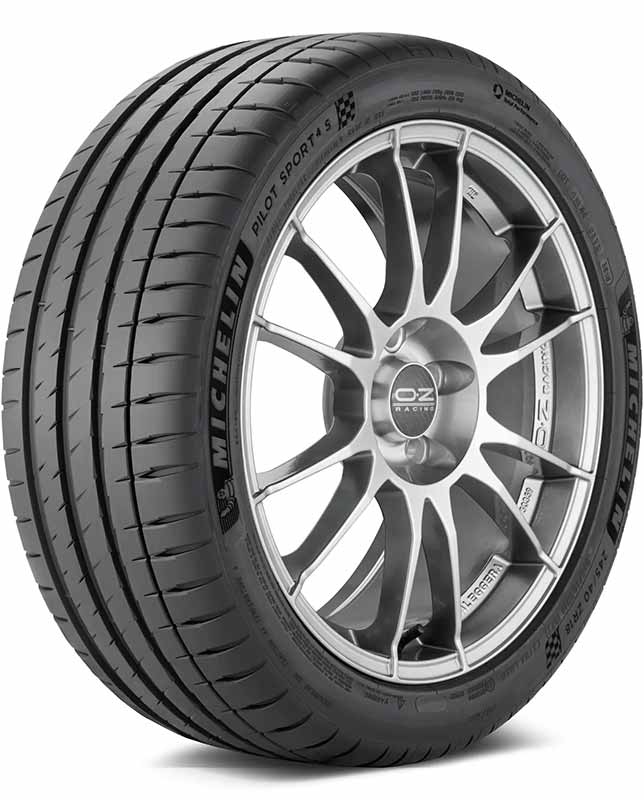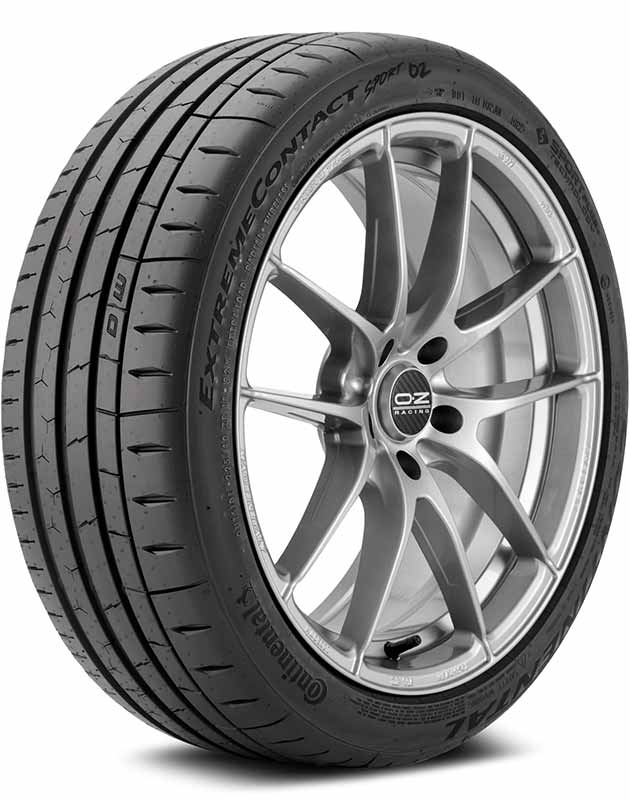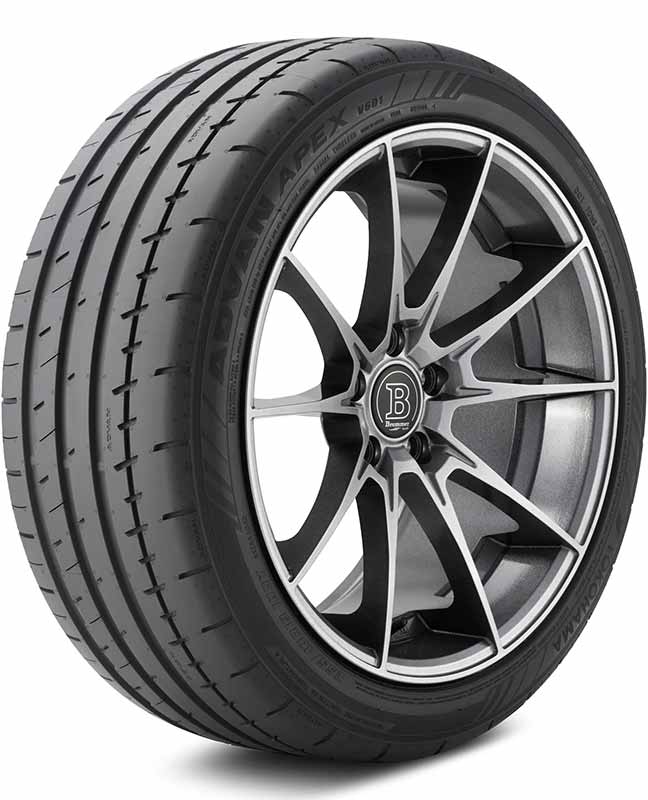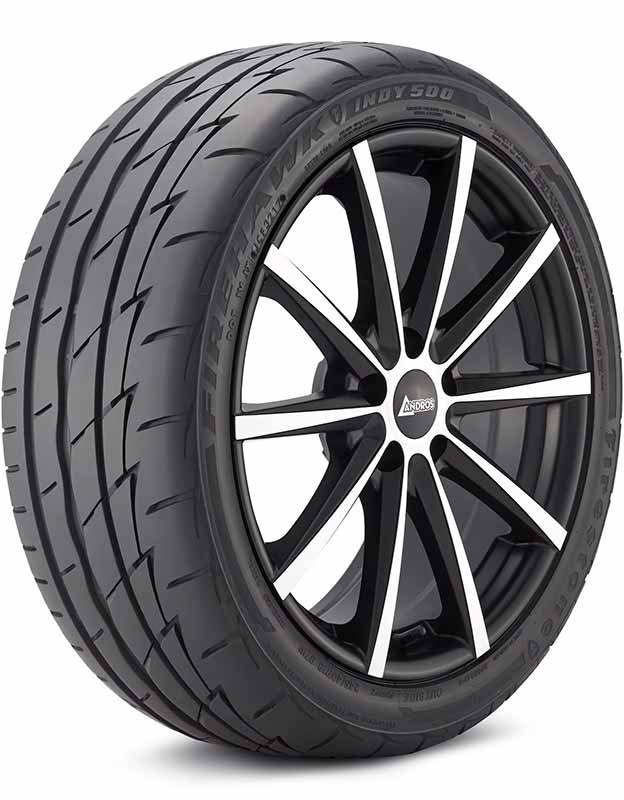Ever found yourself driving through a sudden downpour, feeling each heartbeat echo in sync with the wipers? That’s when the choice of your tires shifts from the back of your mind to the forefront. The Firestone Firehawk Indy 500 promises not just to get you through these heart-pounding moments but to turn them into a smooth ride.
The Firestone Firehawk Indy 500 excels in dry conditions and is very competitive in wet conditions, making it a solid choice for sports car enthusiasts and everyday drivers alike. It is on par with many leading competitors, particularly in terms of dry traction and handling.
In this article, we’ll dive into the nuances of the Firestone Firehawk Indy 500, covering everything from its gripping performance on wet roads to its handling prowess in the dry. We’ll explore how it stands up to rivals and whether it’s the right rubber for your ride.
Firestone Firehawk Indy 500
Customer Rating
Overall Rating
8.6 of 10
Wet Weather
8.5 of 10
Winter Weather
N/A
Tread Wear
8.1 of 10
Dry Weather
9.3 of 10
Ride Comfort
8.5 of 10
UTQG
Uniform Tire Quality Grade
UTQG Treadwear Rating: 340
UTQG Traction Rating: A
UTQG Temperature Rating: A
Mileage Warranty
None
Find The Best Price
Key Performance Metrics
Hydroplaning: 8.4 of 10
Wet Grip: 8.5 of 10
Cornering: 9.3 of 10
Dry Grip: 9.3 of 10
Responsiveness: 9.2 of 10
Mild Snow Grip: N/A
Heavy Snow Grip: N/A
Ice Grip: N/A
Comfort Level: 8.6 of 10
Road Noise: 8.4 of 10
The Firestone Firehawk Indy 500 is engineered for high-performance, catering to drivers of sports cars, sedans, and coupes who demand exceptional handling and responsiveness. This tire combines the latest in tread technology and compound quality to deliver impressive durability and traction under various driving conditions. It exemplifies Firestone’s commitment to advancing automotive tire performance.
Performance Overview
In dry conditions, the Firestone Firehawk Indy 500 excels, with a rating of 9.3, reflecting superior corner stability, traction, and steering response. Its performance attributes stem from a specialized tread design and a high-quality compound that ensures optimal handling and safety.
The tire also holds its own in wet conditions with a rating of 8.5. It provides substantial hydroplaning resistance and wet traction, placing it competitively within its category. The design ensures reliability and confidence during rainy drives, though it doesn’t lead its class.
The Firehawk Indy 500, being a summer tire, is not designed for ice or heavy snow, aligning with standard expectations for its category rather than a drawback.
Comfort and Durability
The tire scores an 8.5 in comfort, offering a smooth and quiet ride suitable for both urban commuting and long-distance travel. With a treadwear rating of 8.1, the Firehawk Indy 500 demonstrates resilience against aggressive driving conditions, although it lacks a treadwear warranty—a common trait among high-performance tires.
Comparison with Leading Competitors
- Wet Performance: Competes well with excellent hydroplaning resistance and traction, nearly matching top performers in its segment.
- Dry Performance: Stands out in dry conditions with outstanding stability, traction, and responsiveness.
- Winter Performance: As a summer tire, it is not intended for use in snow and ice, which is typical for its class.
- Comfort and Noise: Ranks highly in comfort, providing a quieter ride compared to many peers.
- Treadwear: Although durable, the absence of a treadwear warranty is noted, aligning with industry norms for performance-focused models.
Pros
- Superior dry traction and corner stability
- Strong performance in wet conditions
- High comfort levels with reduced noise
- Durable construction with consistent tread wear
Cons
- Lack of a treadwear warranty, although this is typical for high-performance summer tires
Bottomline
The Firestone Firehawk Indy 500 offers an excellent blend of sportiness and practicality, making it a compelling choice for performance enthusiasts. It excels in dry conditions and provides dependable wet performance. While the tire does not come with a treadwear warranty, its build quality and material durability ensure longevity. This tire is ideal for drivers who prioritize dynamic driving and robust performance without compromising on comfort.

Firestone Firehawk Indy 500 Problems
While the Firestone Firehawk Indy 500 is celebrated for its performance in dry conditions and its competent handling in the wet, it’s not without its drawbacks. Understanding these issues is crucial for potential buyers to make an informed decision. Here are some of the noted concerns associated with the Firestone Firehawk Indy 500:
Limited Cold Weather Performance
Primary Issue: As a high-performance summer tire, the Firehawk Indy 500 is not designed to operate in cold weather conditions. Its rubber compound and tread design, which are optimized for warm temperatures, harden as temperatures drop, leading to significantly reduced traction and safety in snow and ice. This is a standard trait for summer tires but worth noting for those in variable climates.
Treadwear Longevity
Concerns Over Durability: Some users have reported that despite the tire’s aggressive performance capabilities, its tread life can be shorter than some competitors. This may lead to more frequent replacements depending on driving habits and conditions.
Noise Levels
Noise Development Over Time: Although initially quiet, several users have observed that the Firehawk Indy 500 can develop a noticeable amount of road noise as the tire wears. This increase in noise can detract from the driving experience, particularly on longer journeys.
Wet Traction Decline with Wear
Decreased Performance in the Wet: While the Firehawk Indy 500 handles well in wet conditions initially, its performance can diminish as the tread wears down. This wear can lead to longer stopping distances and reduced handling capability in rainy conditions, which may pose a risk as the tires age.
No Treadwear Warranty
Lack of Manufacturer Guarantee: Unlike some other tires in its class, the Firehawk Indy 500 does not come with a treadwear warranty. This absence can be a downside for buyers who consider warranty coverage a significant factor in their purchase decisions.

Firestone Firehawk Indy 500 Alternatives
For drivers considering the Firestone Firehawk Indy 500 but looking to explore other options, several alternatives provide comparable or superior performance in various aspects. Below are three notable tires from well-respected manufacturers that serve as excellent substitutes:
Michelin Pilot Sport 4S

Key Features:
- Exceptional Dry and Wet Performance: The Michelin Pilot Sport 4S is renowned for its outstanding grip and stability in both dry and wet conditions. It features a multi-compound construction that provides excellent longevity and performance.
- Enhanced Durability: With a treadwear rating that often exceeds competitors, coupled with a 30,000-mile warranty, the Pilot Sport 4S is designed for longevity and sustained high performance.
- Superior Comfort: Despite its aggressive performance capabilities, this tire maintains a quieter ride and better ride quality, making it suitable for daily driving and high-speed adventures alike.
Ideal for: Performance enthusiasts who need a tire that excels year-round with robust warranty support and are willing to invest in top-tier tire technology.
Continental ExtremeContact Sport 02

Key Features:
- Balanced Performance: This tire delivers excellent traction and handling in wet and dry conditions, thanks to its advanced tread compound and design. It is very much on par with the Michelin in terms of performance capabilities.
- Sport-Tuned Handling: The ExtremeContact Sport 02 is particularly noted for its precise steering response and stability, which enhances driver feedback and control during aggressive driving.
- Warranty and Durability: Similar to the Michelin, Continental offers a 30,000-mile warranty, reflecting confidence in the tire’s durability and performance consistency over time.
Ideal for: Drivers who enjoy spirited driving sessions and need a tire that provides reliable performance in diverse weather conditions.
Yokohama ADVAN Apex V601

Key Features:
- Cost-Effective Performance: The ADVAN Apex V601 offers competitive performance in dry conditions at a price point that is often lower than its Michelin and Continental counterparts.
- Solid Dry Traction: While it handles well on wet roads, its standout feature is its dry road performance, making it ideal for areas with less frequent rain.
- Comfort and Noise Levels: It maintains commendable ride comfort and lower noise levels, which is a boon for drivers who prioritize a pleasant driving experience.
Ideal for: Budget-conscious drivers who do not want to compromise on dry performance but can manage with slightly lesser wet traction.
Summary
Choosing the right high-performance summer tire involves considering various factors including performance in different conditions, durability, comfort, and price.
- The Michelin Pilot Sport 4S is ideal for those who seek the pinnacle of tire technology with no compromises.
- The Continental ExtremeContact Sport 02 offers a fantastic balance of wet and dry capabilities with excellent handling.
- The Yokohama ADVAN Apex V601 serves as a more affordable alternative that excels in dry conditions.
Each of these alternatives provides a viable option to the Firestone Firehawk Indy 500, depending on your specific driving demands and environmental conditions.

Pros & Cons of High Performance Summer Tires
High performance summer tires are designed to maximize road handling and performance in warm conditions. They are crafted from specialized tread compounds that increase grip and agility during high-speed driving. While they offer superior performance in certain conditions, they also have limitations that may affect their suitability for all drivers. Here are the key advantages and disadvantages of using high performance summer tires:
Pros
1. Enhanced Grip and Traction
- Optimal Performance: High performance summer tires are made with a softer rubber compound that provides exceptional grip and traction on both dry and wet roads. This feature is crucial for high-speed driving and aggressive maneuvers, ensuring maximum road contact.
2. Better Handling and Stability
- Precision Driving: These tires are designed to offer superior handling and stability. They maintain stiffness under more extreme driving conditions, allowing for sharper turns and more precise steering response.
3. Improved Braking Performance
- Safety First: The same soft rubber compound that enhances traction also improves braking performance. This reduces stopping distances significantly, providing a safer driving experience during high-speed conditions.
4. Reduced Hydroplaning Risk
- Wet Road Mastery: The tread patterns on high performance summer tires are optimized to expel water efficiently, reducing the risk of hydroplaning on wet roads. This makes them safe for use in rainy weather typical of summer storms.
Cons
1. Not Suitable for Cold Weather
- Limited Seasonal Use: These tires are specifically designed for warm weather. Their soft rubber compounds can become hard and brittle in cold temperatures, severely decreasing performance and can lead to tire damage.
2. Faster Tread Wear
- Shorter Lifespan: The softer compound used for increased grip also tends to wear down faster than the harder compounds used in all-season or winter tires. This means high performance summer tires may need to be replaced more frequently, potentially increasing long-term costs.
3. Poor Snow and Ice Performance
- Winter Driving Hazard: High performance summer tires are not suitable for snow and ice. Their tread design and material composition do not provide the necessary traction for safe winter driving, making them a risky choice in snowy or icy conditions.
4. Higher Cost
- Premium Pricing: Generally, high performance summer tires are more expensive than standard tires due to the advanced materials and technology required to enhance their performance characteristics.
Resources
Below are some links you may find helpful when learning about tires:
Final Thoughts
The Firestone Firehawk Indy 500 emerges as a compelling contender in the realm of high-performance summer tires. It’s crafted to offer exhilarating dry performance and dependable wet traction, backed by Firestone’s legacy in motorsport-derived technology.
Overall, the Firestone Firehawk Indy 500 holds its ground firmly against many in its class. It is on par with the leaders for most performance metrics and exceeds in some, particularly in dry conditions. If your driving primarily challenges the limits on sunny days or wet but not freezing roads, this tire might just be your new best friend on the road.
Good luck and happy motoring.




